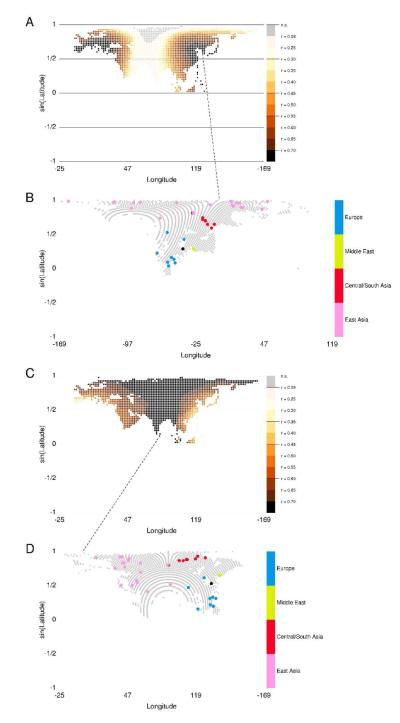Fig. 4.
Relationship of genetic distance and latitudinal and longitudinal distances based on rotated coordinates in Eurasia. A: Partial Mantel correlations between FST and rotated latitudinal distance computed with waypoints, controlling for minimum heterozygosity, at 1641 poles in Eurasia. The color of a point corresponds to the partial Mantel correlation r when population locations in Eurasia are rotated about that point. The range of r values significantly different from zero at the 5% level is [0.0974, 0.7655]; 93.7% of poles produced partial Mantel test results that were significant at the 5% level (among 104 permutations). The model shown had the highest proportion of significant partial Mantel tests of the regressions on latitudinal distance after rotating about poles in Eurasia. B: Rotation of Eurasian population locations about the pole (35.0996° N; 126.2° E), plotted here with ψ0 = −90°. The pole is indicated by an open circle in A from which a dashed line is drawn to B at (90° N; 0° E). The partial correlation between FST and latitudinal distance (controlling for minimum heterozygosity) was calculated using latitudinal distance between population locations after applying the rotation. C: Partial Mantel correlations between FST and rotated longitudinal distance with waypoints, controlling for mean heterozygosity, across poles in Eurasia. The range of r values significantly different from zero at the 5% level is [0.2695, 0.8072], and all poles produced significant partial Mantel tests (among 104 permutations). Note that this means no points are colored grey, nor do any points have the lightest pink color, which indicates 0.09 ≤ r < 0.25. D: Rotation of Eurasian population locations about the pole (7.18076° N; 81.2° E), plotted here with ψ0 = 90°. The pole is indicated by an open circle in C, from which a dashed line is drawn to D at (90° N; 0° E). The waypoint at Istanbul is shown in black in both B and D.

